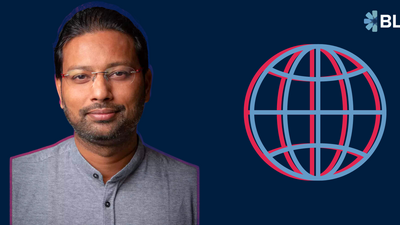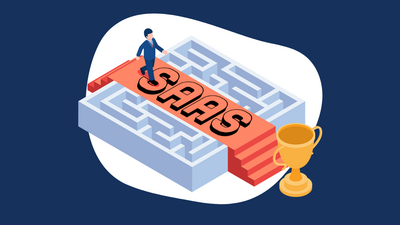Shashank: “You can't take back any features that you've already given. For example, if I said support is free, unlimited support tickets because my UI is bad, my product is still in development, but I can offer unlimited support to a customer with real people answering questions. Now suddenly you can't say that support will be $10,000. Your customers will churn. Or assume that you said at the time of signing early customers that all upgrades and updates are free. Now you have a GPT style AI version that came in, you will have to offer it to them for free. And that's going to be a huge cost to you.”
These are the words of Shashank Bijapur, co-founder, and CEO of Spotdraft, a Contract Lifecycle Management company that helps companies simplify contract management from creation to execution to compliance. I spoke to Shashank to understand their journey from 0 to 100 customers, how they sell in the US from India, and the mistakes early-stage SaaS founders should avoid. I am sharing below his key insights and intuitions as he builds Spotdraft. I hope you enjoy them.
Don’t send ‘lazy’ cold mails, ask for the prospect’s time (not dollars), and nail down your ICP before starting active sales.
Spotdraft had some clients in India but hadn’t sold in the US market. Instead of going for ‘random acts of GTM’ (a term I heard recently from Anurag Wadehra, a renowned start-up coach and advisor) and spending real dollars on active selling, they started an intense customer discovery process to identify their ICP. They sent out over 800 mails in over 3 months to in-house counsels across multiple verticals/sectors, with ~10% conversion to customer discovery calls.
What improved their conversion rate? Instead of being lazy and blasting the same message to all types of prospects, Spotdraft’s founders customized these mails. Firstly, these mails were sent from founders’ inboxes, which makes a lot of difference in people choosing to respond. Secondly, they didn’t use these mails to sell Spotdraft’s software. Instead, they went in with the clear intention of learning about the market from them. Lastly, they personalized the mails for each recipient. They researched the recipients and started with an attention-capturing hook rather than straightaway jumping into asking them to get onto a call.
Shashank: “These were hyper specific emails. So the emails would almost be like Rohit, lets say you have Max as your dog and you put up a photograph on social media. So the mail will almost be like Hey, I just saw your photograph with your dog Max, and I love it, by the way. I also have a Labrador who's eight years old. The reason I'm writing you this email is because I am on this journey to launch our contract management product in the US. So I'm trying to get in touch with legal leaders like you to learn from you and understand what your current pain points are and how you're solving them. Just to be clear, this is not a sales email. I really want to learn. And that was the intention that we would go with.”
Here’s sample content from one of their mails.
Subject: (Personalized)
Hi (First Name),
(Personalized Relevance Hook)
My co-founder and I are considering expanding our Al-driven legal tech startup, SpotDraft into the U.S. market.
Before making any potentially costly decisions, I'm trying to learn from leaders like you as it relates to the biggest challenges you may have around cross-functional collaboration and contract compliance (and if you use any Al/machine learning tech).
Also, this isn't a veiled pitch, just really seeking to learn from people like you. Happy to share any insights learned from your peers too.
Excited to hear from you, (First Name)!
-Shashank
The discovery calls indexed on a few questions that helped them go deep into the buyer persona.
- Do you have this pain point? How strong is it?
- How are you solving it right now?
- Is there a budget and ownership internally to solve it?
- Is it urgent for you to solve it?
Also, they sampled the recipients carefully, targeting prospects across sectors, geos, company sizes, etc., to make the discovery process robust.
Shashank: “We were experimenting with our ICPs. Some ICPs worked well. Some didn't work well. But we did have a robust way of identifying who we were sending our emails to. Looking back, we realised that why would a nasdaq listed company sign up to an unknown small company. We had to work with some comparables to start with.”
Let go of your assumptions about your ICP sooner than later in the discovery process to save time and money.
While their assumptions about the pain point’s existence were correct, the ICP they thought would have the greatest pain point was unwilling to consider them. They started with the enterprise segment but realized that enterprises were already using other software. Given the annual contracts, education, and internal change management, it is always harder to convert someone from another tool to a new one.
Shashank: “Looking back, we could have handled things differently when we first noticed that the enterprise market wasn't the right fit for us. We should have quickly adjusted our focus to target mid-market or SMB instead. However, as founders, we sometimes fall victim to the gambler's fallacy. We invest more money or time to make up for what we've lost. We thought, "Maybe we're looking at the wrong sector. Maybe it shouldn't be finance, but manufacturing." We could have minimized our losses by making the switch earlier. Instead of spending three months, we could have spent just one and moved on.”
Outbound sales are a faster and more intentional way to validate your ICP than PLG or inbound sales.
Spotdraft chose to go for outbound sales for a variety of reasons - they didn’t have a marketing function when they started that could churn content, they didn’t have the funds to spend on digital ads, and SEO has a long lead time before it becomes effective (for a while Spotdraft’s website wasn’t the first thing that came up when you searched Spotdraft contract management).
But most importantly, they wanted to validate the pain point and nail the ICP fast, and Shashank believes there’s no faster way to do this than outbound sales.
Shashank: “We wanted to validate the market faster. This is the faster way of doing things, where you ask leading questions, "Do you have this problem? This is what I'm building. And all founders must know this is the best way to do it. We also wanted to experiment with who our ICP is instead of the reverse, where people are coming to us through our website, and we say, "Ah, this is our ICP. So to identify that, we had to go to every cohort, like mid-market, SMB, mid-level person, top-level person, venture-funded, and traditional businesses. We had to run that entire gamut of experiments to realize which one made sense.”
Don’t offer custom low pricing forever, worry more about the future price than today’s price, and create a pricing model that has scope for future expansion revenue because raising prices yearly is not easy.
Here are some common pricing mistakes that Shashank wants you to avoid.
You should have an end date and an internal thesis on transitioning out of ‘not indexing on price’ and offering highly custom prices to prospects to close a deal. While it’s a good thing to do early on if you do it for a long time, your pricing will be all over the place, and you’ll end up leaving a lot of money on the table. For Spotdraft, they stopped doing this at around 30 customers.
You’ll often hear that you should not worry about price in the <$1M ARR zone. You have a fledgling product, and you should focus on acquiring customers to get product feedback and build the product, as you can always increase the price later. However, Shashank believes that you cannot increase your price manifold suddenly, and you should be more concerned about where you want your price to be, not today but in a few years.
Shashank: “I felt like we could have been a little more bullish on how strongly we went in with pricing. I may not have been in the best, in the most bullish frame of mind when we were doing pricing. So I would always go in with a little bit of hesitation. And the instruction I had given was, no matter what, we'll figure out a way to work. Somehow we'll make it work in our budget. Because at that point, you also don't know what is the real market value of what you're trying to sell.
"Increasing the price is difficult because once you hit the baseline, you can only go to 20 %, 30 % higher the next year. In an ideal world, you want the pricing to increase because of usage, not because the year has changed. So a great pricing model is where the usage will end up determining how much they need to pay, and that's built-in. So you not only need to think through what your price is today but how you want your price to grow in the next few years and then set your current price like that.”
At an early stage, your pricing model should leave scope for future expansion and revenue growth. So, what you offer at a price point is more important than the price itself. If you offer 10,000 API calls monthly (to sweeten the deal for your customer), but your customer uses only 1000 API calls monthly, you lose out on future expansion revenue because the customer will not have any need to move to a higher tier or buy any add-ons in their current tiers, as they cannot even fully use the value in their current tier.
Shashank: “You can't take back any features that you've already given. For example, if I said support is free, unlimited support tickets because my UI is bad, and my product is still in development, but I can offer unlimited support to a customer with real people answering questions. Now suddenly, you can't say that support will be $10,000. Your customers will churn. Or assume that you said at the time of signing early customers that all upgrades and updates are free. Now you have a GPT-style AI version that came in, you will have to offer it to them for free. And that's going to be a huge cost to you.”
During the discovery phase, be deliberate about qualifying prospects to the sales funnel, keep the discovery call separate from the sales call, and don’t over-index on price.
Your early customers will fall into one of the following three buckets. Bucket three is the hardest to convert, and bucket two is the easiest.
Shashank: “(Bucket 1) people who are currently looking at an alternative. They were looking at one of our competitors and said, “hey, I'm just about to close with X.” I said, okay, if you're about to close with X, go ahead and close it. We are also trying to see how we compare against our peers. So would you like to see a demo of our product and tell us how we fare?
(Bucket 2) The second cohort was, hey man, great timing. We're actually looking for this. Like we desperately need something, let's go ahead and see your product.
(Bucket 3) And the third was where they were extremely tired of the current way of doing things and wanted to look at alternatives. So they already had a tool in place that did not work well.”
Shashank suggests that even during the customer discovery phase, you should be alert to see if there are people who could be potential customers and move them from the discovery process to the sales process. After all, you are a scrappy startup and shouldn’t let go of a potential customer.
They qualified such prospects by looking through the BANT lens (Budget, Authority, Need, Timing). Here’s where Shashank believes that need is the most important factor, more important than timing.
Shashank: “So need is the strongest pull. And then comes budget, then comes authority, then comes timing. Some will say timing comes first, but if there is a need, then the timing is right. That's our understanding.”
He also recommends keeping the discovery and sales calls separate during the customer discovery process and even afterwards when you are actively selling.
Shashank: “The first discovery call is, what's the problem? What are your symptoms? How are you solving it right now? And then, you schedule the follow-up surgery or anything else required. In most sales conversations, there's always a robust discovery process where you qualify or disqualify a prospect and then move forward.”
Spotdraft didn’t mind selling at a discount to their early customers (especially in bucket 3, as they had switching costs). Instead of a higher price, they indexed on getting feedback from these early customers and co-opt them into product development.
Shashank: “So we would tell the new customer, hey, you promise that once a week, 1 hour you're going to spend on how you use the tool and what you did right and wrong, that for us is more important than getting money when you have just started selling.”
Selling is not the hardest part. The real challenge starts once a deal is closed.
Shashank believes the real challenge for an early-stage startup isn’t selling the product but what happens after a customer signs up - onboarding and collecting feedback to build the product. Happy customers mean more potential customers because of the network effect of the word-of-mouth that travels. He recommends building these systems even before you’ve made the first sale.
For instance, in the first few months, Spotdraft was still building a customer onboarding and activation process/team to ensure the customers were using the product and aware of its features.
Secondly, while they wanted to collect feedback from early customers, they didn’t have a robust feedback collection system to channel it into the product roadmap right out of the gate, and it took them time to build it. And then there were other teething issues.
Shashank: “When an Indian company starts selling to US customers, you need to take care of a lot of things. For instance, what’s the right way to accept payments in USD, how to properly take care of TDS and other tax-related things, how long remittances will take to hit our accounts, whom to talk to if a remittance gets stuck somewhere, etc. While now there are people here who know this like the back of their hands, early on, it took us a couple of months to figure all these things out.
Transitioning from founder-led sales requires more than knowledge sharing. You will need to tweak your messaging, as the messaging that works when a founder does a demo will not work when someone else does it.
As a founder doing early sales, don’t expect to flip a switch and expect someone else to take over from you. Your transition plan should include the sales leaders shadowing you and then you drawing guidelines for the types of calls you will do and the ones that sales org should do.
Shashank: “So Akshay, who is our VP of Sales, would join me on calls. Once he started joining me on calls, I weaned off these calls and Akshay took over. I would join may be some calls where the decision-maker was joining so the team wanted me to be there. So the number of calls I had to do dropped by half. Then we hired more account executives on our teams. They started joining my VP of Sales on calls. Then that knowledge sort of spread.”
As you make this transition, you’ll also need to rework your messaging from the cold mails (because these aren’t going from founders now) to demo calls.
Shashank: “Then we realized the things that work for founder-led sales, both in terms of messaging that goes out in emails to what really happens on those calls. It doesn't work. So then we started doing value-driven emails, like, outcome-driven emails like, hey, how would you like to, I don't know, save 80% time managing contracts? So that's how we started. We experimented a lot with different types of mail like we started sending memes, we started sending... We said, Hey, if you get on the call, we'll give you a $50 Amazon gift card, incentivizing them. That didn’t work well, which is obvious in hindsight.”
When you scale from 10 to 100 customers and beyond, outbound sales will plateau. Hence, it is important to bring inbound sales into the mix and set up a formal marketing function to keep the sales engine revving.
Shashank shares that outbound sales cannot scale beyond a point. While 75 of Spotdraft’s first 100 customers came from outbound sales, they saw a significant decrease in conversions from emails sent to paid customers as they scaled.
For one, there are rate limiters. For instance, you cannot send unlimited cold mails to prospects as Google will start marking you as spam. Similarly, you cannot send unlimited automated LinkedIn messages as LinkedIn caps them. That limits how wide a net you can cast once you are past the early adopters. Also, when mails stop going from founders and founders stop coming to the calls, there’s a natural drop in the percentage of people who respond to you.
Shashank: “You also can't keep sending the same message over and over again because, then again, it is labeled as marketing or promotion, or spam. An email has to land in somebody's inbox. That person should be interested, should have a need, and then they should open that email and respond to that email. Only then it comes. It's a volume game, but it is rate limited by how, let's say, Gmail functions as a thing. And it's not only one email you need to send multiple follow-ups. There's a drip campaign that goes by.
The propensity to come on to calls reduced. We didn't realize that this was because the founders were not coming.”
Spotdraft set up a formal marketing function at this time (100 customers mark) and ramped up their inbound marketing. They invested in creating content - case studies, video podcasts, and white papers, and using ads to drive prospects to them. But the channel that’s given them the best return is events. This is because the legal industry is already heavily driven by events that see a strong presence of legal counsels, Spotdraft’s ICP.
Shashank: “We started doing events. Legal technology is a very event-heavy business. We also started doing ads. Linkedin ads, Google ads, and video ads. We started doing a lot more SEO. We started getting ourselves listed on all these G2 and Capterra type comparison websites. All of these things started happening. While the intensity of outbound didn't reduce, we started getting a lot more inbound than outbound. Outbound started stagnating, but we weren't really affected by it because inbound took over and did probably 3X of what outbound was doing. “
An important point Shashank mentions is that while the sales funnel is split into inbound and outbound from an attribution perspective, what is important is to have a strong share of voice in whichever market you operate, as all these touchpoints come into play when closing a deal.
Shashank: “Probably what ended up happening was you saw an ad, you saw a friend download it, you're watching cricket, and their ads were there on the fence. Then you saw some tweets. Then you saw some other review that somebody wrote about it or a news article. All of that led to you one day downloading the app.
So outbound, while it is now a smaller portion of what we do, plays a very significant role in conversion. When we do ads, we do events, the same person is shown an email, then added to our newsletter, subscribes to our podcast, and then sends a demo request. So the end result may be like inbound there. But the actual reason could also be an outbound email that was sent like three months ago.”
As you scale from 10 to 100 customers, avoid selling unlimited everything and set guardrails for things you’ll not do as you scale.
One of the things Shashank cautions early-stage founders not to do is to sell anything that is prefixed by ‘unlimited’ as you may end up with that one customer who actually demands everything unlimited and takes out all engineering and product development bandwidth.
Shashank: “We initially did deals where we gave unlimited of everything under the understanding that you can't eat unlimited. But what we did not anticipate is that people were not making prudent decisions as it wasn’t costing them anything. When we asked them, what do you want to implement? They'll give us two contract types. We implement that, and they’ll send two more contract types. So the delivery was a continuous delivery and continuous integration process.”
Another thing he suggests founders should do mindfully is to be very mindful of what they’ll say no to as they scale. Saying yes to everything becomes a huge distraction as you grow and doesn’t help the product evolve.
Shashank: “Most SaaS products need to integrate with other products. Now, our stance was not to say no to a customer for an integration. So any integration with any tool, we'd say yes. Now, people wanted to integrate with tools that they had built internally that even they didn't have any documentation on. There was no proper API, so delivery became a problem.
I think we have greatly reduced this over a period of time. We now know for sure what we are definitely not going to build. We will not build anything that is on-premise. We will not build anything that is that does not have at least five open customer requests. For anything to be built, we should have lost deals worth a certain dollar amount else it’s not worth building.”
Just so that you know, Spotdraft isn’t a Blume Portfolio company.
Sigh!







